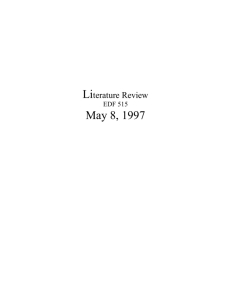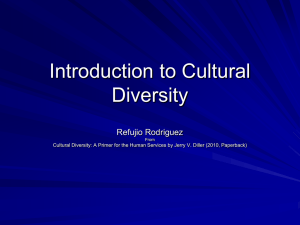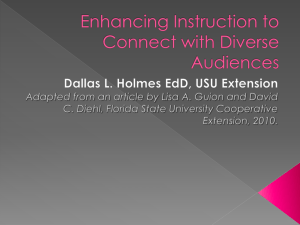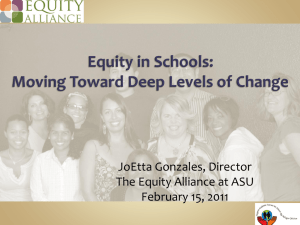File - Becoming a Culturally Relevant Educator
advertisement
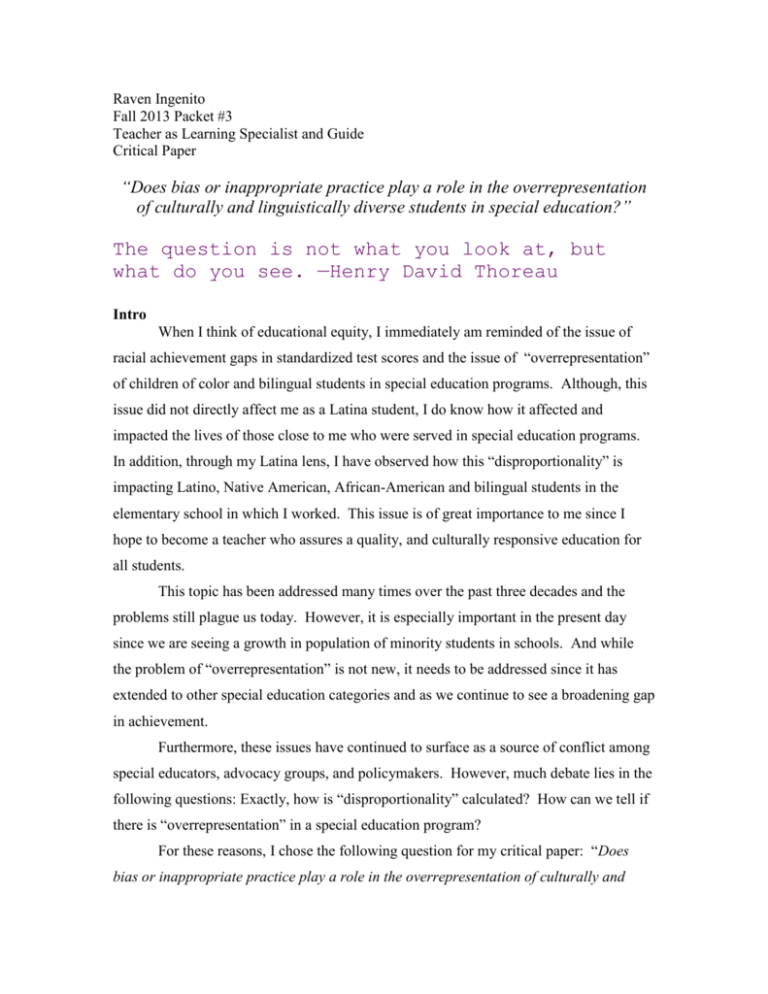
Raven Ingenito Fall 2013 Packet #3 Teacher as Learning Specialist and Guide Critical Paper “Does bias or inappropriate practice play a role in the overrepresentation of culturally and linguistically diverse students in special education?” The question is not what you look at, but what do you see. —Henry David Thoreau Intro When I think of educational equity, I immediately am reminded of the issue of racial achievement gaps in standardized test scores and the issue of “overrepresentation” of children of color and bilingual students in special education programs. Although, this issue did not directly affect me as a Latina student, I do know how it affected and impacted the lives of those close to me who were served in special education programs. In addition, through my Latina lens, I have observed how this “disproportionality” is impacting Latino, Native American, African-American and bilingual students in the elementary school in which I worked. This issue is of great importance to me since I hope to become a teacher who assures a quality, and culturally responsive education for all students. This topic has been addressed many times over the past three decades and the problems still plague us today. However, it is especially important in the present day since we are seeing a growth in population of minority students in schools. And while the problem of “overrepresentation” is not new, it needs to be addressed since it has extended to other special education categories and as we continue to see a broadening gap in achievement. Furthermore, these issues have continued to surface as a source of conflict among special educators, advocacy groups, and policymakers. However, much debate lies in the following questions: Exactly, how is “disproportionality” calculated? How can we tell if there is “overrepresentation” in a special education program? For these reasons, I chose the following question for my critical paper: “Does bias or inappropriate practice play a role in the overrepresentation of culturally and linguistically diverse students in special education?” I have divided this critical paper into the following sections to explore related literature. These include: (1) The Problem of Overrepresentation, (2) Problems in Special Education, and (3) Proposed Solutions. The Problem of Overrepresentation According to Artiles & Harry (2006), the special education system has “faced legal actions for the last three decades when too many (overrepresentation) culturally and linguistically diverse students were placed in disability programs” (p. 4). This problem affects African Americans, Latinos (as), American Indians, and low-income students or children who do not speak English as their first language (Artiles & Harry, 2006). These students are often over-represented in learning disability, mild mental retardation, and emotional/behavioral disturbance programs (Artiles & Harry, 2006). For example, African American students are 2.88 times as likely as white students to be identified and placed in MR (mental retardation) programs, 1.92 times as likely to be identified and placed in ED (emotional disturbance) programs, and 1.32 times as likely to be identified and placed in SLD (specific learning disability) programs (Parrish, 2002). These odd ratios are statistically significant for all three high-incidence disability categories. Additionally, the federal data from 2007 revealed that African-American students represented seventeen percent of the U.S. school enrollment but more than twenty percent of the students classified with specific learning disabilities (Rebora, 2011). Similarly, Latino students made up just over twenty percent of the school population but almost twenty four percent of students classified with learning disabilities (Rebora, 2011). Then in 2008, government data confirmed that African-American students were nearly or greater than twice as likely as white students to be classified with emotional or intellectual disabilities (Rebora, 2011). And since, it is estimated that about twelve percent of the current student population experiences some type of disability, one would expect that the incidence of students who have disabilities would be equally distributed among different student populations (u.k., 2008). However, as the data attests, this is not the case. Instead, the statistics reveal that there’s something going on behind the scenes. Overrepresentation is a problem if students are placed in special education when they do not have disabilities; if decisions to place students in special education will limit their opportunities for other positive experiences; and if decisions to place students in special education are due to stereotyping by peers or by teachers (Artiles & Harry, 2006). These issues touch on many elements of educational practice, from the referral process for special education, to the instructional strategies used by teachers, to our beliefs about poverty, race and culture (u.k., 2008). According to u.k. (2008), over-representation of minority students in special education is a problem that” affects educational equity in our country” (Factual Information section, para. 2). U.k. (2008) further explained that, equity is affected because “misidentifying students might cause their educational experiences to become unnecessarily limited or might cause educators to limit their expectations for these children” (Factual Information section, para. 2). What’s more is that; misidentification also denotes that special education resources meant to be used for students who have actual disabilities are misdirected (u.k., 2008). Placement in special education can often make matters worse for these students. Rebora (2011) explained that, divorced from the regular academic curriculum and environment, these students “tend to have poorer academic and career outcomes than their peers, including much higher high school dropout rates” (para. 6). Furthermore, Rebora (2011) provided that, compounding the problem is the “enduring stigma that the special education label can have on students who don’t belong there” (para. 6). Problems in Special Education A direct correlation exists between the problem of overrepresentation and assessments. The principal reason for the disproportionality of culturally and linguistically diverse students in special education is biased assessment practices (Baca & Cervantes, 1989). Jones (1976) maintained that bias is involved at three different levels: (1) at the content level where the decisions are first made about what items to include in a test, (2) at the level of standardization where decisions are made about the population for whom the test is appropriate, and (3) at the point of validation where efforts are undertaken to determine whether or not tests accomplish what they have been designed to accomplish. Examiner bias is another important factor causing overrepresentation (Baca & Cervantes, 1989). Examiners are not always adequately trained and prepared to use tests as aids. If testing is to remain an important function, those administering the tests must become well versed in their use. An additional significant variable is the ethnic background of the examiner (Baca & Cervantes, 1989). It appears that matching the ethnic and language background of the examiner and the student does make a significant difference (Baca & Cervantes, 1989). A large body of work suggests that reading difficulty may be a factor in special education referral and placement decisions (International Reading Association, 2003). Statistics reveal, for example, that eighty percent of the children referred for a specific learning disability are referred because of reading problems (Snow, Burns, & Griffin, 1998). This is a considerable amount of children because specific learning disabilities account for approximately fifty percent of the children placed in special education (U.S. Department of Education, 2001). While there is no direct data connecting reading difficulties to the two other special education categories, it is believed that early reading difficulty is a factor in special education referrals (International Reading Association, 2003). The International Reading Association (2003) discussed that, reading difficulty “may trigger concerns about learning that result in MR (mental retardation) placements” (p. 2). Furthermore, they (2003) suggest that emotional disturbance referrals and placement is also linked to reading difficulties. This is due to the following facts: reading difficulty is often linked to failure, and consequently, failure is frequently associated to misbehavior. According to the International Reading Association (2003), diverse learners are more likely to be referred for additional testing and placement in special education programs because “achievement tests typically do not assess literacy skills that they may have acquired outside school, and these skills often differ from the ones these children are expected to have when they enter school” (p. 2). The International Reading Association (2003) recommended that, if the issue is reading, the more appropriate educational response “is to match children’s individual learning capacities and needs with the most appropriate reading instruction within the least restrictive environment, such as the children’s classrooms” (p. 2). Artiles and Harry (2006) informed us that, “several formulas are used to assess overrepresentation” (p. 4). They (2006) shared that one way of assessing “overrepresentation” can be done by “calculating the odds students from one ethnic group have to be placed in a special education program compared to students from another ethnic group (or compared to all other groups)” (p. 4). Since, researchers may not agree on this issue, it has been suggested that one should seek assistance from the school administration or parent advocates in helping to determine if there is a problem at a school (Artiles & Harry, 2006). Proposed Solutions Rebora (2011) established that, scholars generally “don’t blame racial disproportionality in special education on outright discrimination” (What Schools Can Do section, para. 1). Instead, Rebora (2011) imparted that; they say “it typically derives from systemic flaws within a school or district’s instructional culture that allow for some disadvantaged students to fall through the cracks” (What Schools Can Do section, para. 1). Since, these problems are specific to an individual school’s system, a comprehensive analysis will be required to identify them (Rebora, 2011). In spite of this, there are a variety of steps school communities can take to address or prevent overrepresentation issues. First, schools facing a disproportionality problem should seek to foster honest, though tactful, discussions on issues of race, academic achievement, and pedagogy (Rebora, 2011). It’s important to get educators to explore their own experiences and perspectives and then to examine their practice and their curriculum. A starting point for change could be addressing cultural biases that educators may be relying on to justify high rates of special education referrals for minority students (Rebora, 2011). Another way to help detect and address problematic racial academic patterns is by honing in on student-performance data and examining student data holistically (Rebora, 2011). This is especially significant because hard data provides teachers with a solid basis for responding to students’ learning needs and evaluating their development (Rebora, 2011). Furthermore, school systems with “overrepresentation” problems tend to lack curriculum frameworks that are well articulated, contain many inconsistencies, and exclude or fail to resonate with particular subgroups of students (Rebora, 2011). Rebora (2011) further described that, the materials don’t have “a good scope and sequence and curriculum map that show the teachers what they could be doing and where they should be at different parts of the school year, given the standard they need to meet for the state” (Heal the Curriculum section, para. 1). School leaders also need to ensure that curriculum does not exclude or fail to resonate with particular subgroups of students (Rebora, 2011). Rebora (2011) recommended that, to minimize the potential for added referrals, school leaders should “ensure that teachers receive sustained training in high-frequency problem areas like classroom management, English-language learner instruction, literacy development, differentiation, and culturally responsive practice” (Tailor Professional Development section, para. 1). In addition, schools detecting signs of disproportionality should introduce rigorous academic interventions, in the form of individual or small-group instruction, to provide added support for students who are at risk of falling behind. However, interventions must be carefully planned, based on validated instructional practices, and most importantly, closely monitored through student-performance data (Rebora, 2011). It is better to implement interventions earlier and more broadly than schools are accustomed to (Rebora, 2011). There are things individual classroom teachers can do on their own to respond to, or at least not contribute to, the overrepresentation problem. After all, they are the ones who often initiate the special education referral process. First, teachers need to acknowledge their own limits (Rebora, 2011). If a teacher is experiencing difficulty getting through to students, they should seek advice and support from colleagues (Rebora, 2011). Observing the classrooms of more experienced teachers or partnering with staff members who have needed expertise is also valuable (Rebora, 2011). Teachers should familiarize themselves with proper protocols for getting assistance (Rebora, 2011). To ensure students are on pace, teachers should closely monitor progress data at least every two weeks (Rebora, 2011). By consistently reviewing students’ work, teachers can gain an understanding of whether the kids are getting the material as intended. Then they can hone in on linking their teaching to the learning that’s actually happening (Rebora, 2011). Since, a prominent factor in minority special education referrals is disciplinary problems, teachers should try to understand the motivation behind the behavior taking action (Rebora, 2011). By being more cognizant of a student’s issues, in turn, you help students address them. Importantly, teachers shouldn’t make assumptions about a student on the basis of behavioral issues. Teachers in diverse classrooms may need to gain a better understanding of how their own viewpoints and preconceptions about schooling differ from those of their students (Rebora, 2011). Teachers should be conscious and deliberate about their own roles, their own belief systems, and how that sometimes connects inconsistently with their students (Rebora, 2011). Forming faculty book-study groups around texts that speak to issues of education and ethnicity will help bridge cultural divides in the classroom (Rebora, 2011). All teachers have to handle a variety of behavior problems in class which require the teacher to attend to the individual child’s emotional needs while at the same time dealing with the less serious, mainstream behaviors of average students. At all times, the teacher should make sure to demonstrate care and concern about the child. What counts most, is the teacher’s approach. Therefore, behavior should be positively reinforced, in a culturally appropriate manner (Baca & Cervantes, 1989). It is important to remember that a child’s ability to learn may be submerged by emotional disturbance (Baca & Cervantes, 1989). According to Baca and Cervantes (1989), remediation must be done “within the context of the child’s home and community cultural values” (p. 274). Teachers will definitely encounter students with emotional and behavioral problems. Therefore, they will also be required to possess basic counseling skills. These skills will help them provide guidance to both students and parents. These basic skills must be present for the development of healthy relationships: genuineness, respect, and empathy. In addition, teachers will need to be open and honest, but do it with sensitivity. As a good counselor, they will need to possess the following: a good knowledge of the strategies for working effectively with students and parents; a good understanding of students’ and parents' perspectives; an awareness of family dynamics; and a knowledge about the range of services and other resources which are available to parents. In addition, they will need to be aware of the diversity, for instance, in beliefs and customs of the ethnic groups with which they work. This will require that they adapt their interventions and make them culturally appropriate. Other skills they will need to acquire are excellent interpersonal skills such as listening, assertion and collaboration, organization and communication, integration, and leadership. The teacher’s goal should be to foster a healthy, safe and supportive learning environment. Such an environment promotes innovation, inquiry, and risk taking. This will create an atmosphere of sincere support for the students' well being and academic success. Final Thoughts “Do as the bull in the face of adversity:/charge…” –From To the Persecuted by Jose De Diego “Aquel que no se siente orgulloso de su origin nunca valdra nada pues empieza por despreciarse a si mismo”-Pedro Albizu Campos Overrepresentation is no doubt a complex problem that has been influenced by systemic flaws in school and district institutions. Arguments about overrepresentation of culturally and linguistically diverse students still remain critical issues to be resolved. Resolutions will need to come by means of analysis, dialogue, reflection, reforms, and most importantly, discussing cultural biases. As Delpit (2002) highlighted in her book, The Skin That We Speak: Thoughts on Language and Culture in the Classroom, “children come to school with different experiences” that are “culturally driven” (p. 128). And just as students arrive at school with these varied and culturally driven experiences, so do teachers, administrators and other school staff members. Teachers and schools need to be equally accepting of these children and families’ cultures and languages as they are of their own. They need to be sensitive to their experiences, beliefs, and understandings (Delpit, 2002). Teachers and schools must examine themselves and ask what is wrong with the way we are teaching these students (Delpit, 2002). As a forthcoming Latina teacher, I am faced with entering an institution that has views of “common sense” (or “generally accepted practice”) regarding issues of culture and language that clash with that of my own. I have vowed not to alter my attitude to reflect that of mainstream common sense. As Delpit (2002) explained, this will result in my search for ways to “maneuver through this dangerous territory of two conflicting conceptions of cultural and linguistic reality” (p. 182). This will entail that I become deeply rooted in educational achievement through my strong connections to my loving Latino family and community; combine my home language with educational motivation and achievement; ensure that Latino concerns are central and play a key role in my consciousness; and validate my cultural identity, history; and future possibilities (Delpit, 2002). According to Delpit, (2002), I understand that it may also require me to “deliberately deviate from lessons in order to culturally support my students” (p. 186). When I worked as a parent volunteer and teacher assistant, I never conformed to mainstream standards and therefore, have no future plans to. Instead, I vow to continue with my tireless effort in making revolutionary changes for the growing minority population of students. All the while, remaining to take up issues of cultural and linguistic diversity. Delpit (2002) emphasized that, “mainstream common sense, although pervasive and powerful, is not truth” (p. 201). The key is to see and question mainstream common sense (Delpit, 2002). Once this is accomplished, one can cultivate an alternative common sense of “the game” (Delpit, 2002). Delpit (2002) clarified that, this game is about “maintaining appearances but, most of all, it is about maintaining the confidence to defy the official institutional messages and to construct one’s own standards, standards rooted in cultural and experimental common sense” and the same Latino self-love which enabled them to achieve academically in the first place (p. 201).
